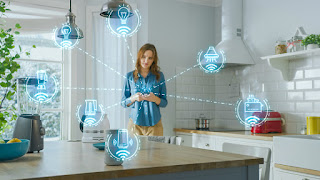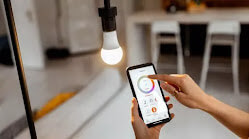This post is about to enlighten you on what home automation is all about. Please read through the paragraph so you don't miss any vital information.
How do you feel when you are on your bed and you discover you did not off your bathroom light That stress can be a thing of the past with a smart bulb that you can control wirelessly by syncing it with a mobile app on your phone or smartwatch.
House automation, sometimes known as a "smart home," is the automatic and electronic management of features, activities, and appliances in a home. In layman's words, it implies you can simply manage the amenities and features of your home via the internet to improve convenience, increase security, and even save money on utility costs.
Home features including lighting, climate, entertainment systems, and appliances will be monitored and/or controlled by a home automation system. Home security measures like access control and alarm systems could also be included.
How Does Home Automation Work
The operation of this system can be characterized in simple words as the Internet-based interconnection of hardware, electronic, and communication interfaces that connect household devices. As Wi-Fi connects the sensors in gadgets, you can control them from any location using a smartphone.
Home automation systems come in two main categories today: wired and wireless. Wireless home automation solutions are perfect for both new and existing facilities, whilst wired systems are appropriate for brand-new buildings.
How is home automation implemented? It operates on three levels, which include automation, control, and monitoring.
Monitoring enables users to keep a close check on the connected devices through a mobile app.
Control allows users to take over their devices remotely, such as turning on the AC and adjusting the thermostat to set the right temperature
Automation includes calibrating the devices to trigger each other, like setting off the alarm system when motion is detected
What Aspects Of The House Can Be Automated
LIGHTING
One of the most popular and practical automation subsystems is architectural lighting, allowing you to enable and disable all kinds of light sources. For instance, you can dim the dining room lights while brightening the porch lights as you sit down for dinner. Lighting can also be synced with other subsystems such as the security system to provide even greater benefits, as the lights can turn off and on according to the settings of the surveillance system or the position of motorized drapes, for instance.
SECURITY
In in terms of security, a smart home security system enables you to lock doors, arm and disarm sensors, and examine system status all from the same device. For instance, sensors that are designed to activate an alarm when they detect motion may also activate a pathway of lights.
HEATING AND COOLING
With the help of a home automation system, you may program each thermostat from a single screen. Once they are set up, you can use this one control device to check the temperature in each heating and cooling zone and make any necessary adjustments. The ability for the temperature to change automatically based on specific circumstances is another benefit of adopting an integrated home automation system. Your thermostat may change, for instance, as the sun rises or sets, when the home entertainment system kicks on, or when the motorized window treatments draw.
AUDIO AND VIDEO
Music can be broadcasted from equipment in a media room to speakers all over the house on command using an automation system. The same with television. Your home's lights may change in time with the music if the automation system has been designed to do so. The best approach to a home setup is through marketing automation. With the press of a button, the ideal atmosphere can be created for a joyous get-together of friends, a romantic evening at home, or a dinner party.
Control Protocols For Home Automation
The way that Io T devices connect to the Internet and each other is their control protocol; if IoT devices are people, think of the protocol as their common language. Like on Earth, there are a few different languages, or protocols, that devices can speak, including:
WiFi: WiFi is by far the most common control protocol; it means that your IoT device will use the regular Internet provided by your Internet Service Provider. While this doesn’t require an additional hub, note that it can slow your web surfing speeds down, especially if you have a ton of different IoT devices set up at once.
Z-Wave: Don’t want to mess with your home’s WiFi? Z-Wave is a wireless technology that won’t interfere with your WiFi; rather, it operates on low power at 908.42 MHz in the U.S. and Canada.5
ZigBee: Similar to Z-Wave, ZigBee is a mesh network and universal language that lets IoT devices communicate.
Thread: Thread is another low-power, wireless mesh networking protocol based on an IP address open standard; it lets Io T devices connect to each other and the cloud.
Bluetooth: Finally, Bluetooth is another mesh technology that lets people control and monitor IoT devices and automate systems.
For most people, WiFi-connected devices will be sufficient, but for more advanced smart homes, you should switch to a mesh network like Z-Wave or ZigBee.
Advantages And Disadvantages Of Home Automation
Advantages
1. Ease of Access
Ease of access is a huge advantage if you have a smart home. If you forget to turn off your geyser after a warm shower or leave the AC remote somewhere and can't find it, you can make things work remotely via the voice-activated system or an app. Home automation technology is an effective way to get things done easily, even if you are not at home.
2. Energy Savings
You can save more on your electricity and utility bills as your home is equipped with automated monitoring systems that let you use the technology efficiently. Most smart devices are based on human technology and power off automatically after sensing your absence. So, from heaters to Air conditioning systems, you contribute to saving energy sources.
3. Home Automation is Necessary for patients
Doing basic things is cumbersome for people with disabilities. One of the greatest advantages of home automation is you can get things easily. You can turn lights or fans on/off, close the blinds or even lock your home from the comfort of your couch. Home automation benefits you, especially when you live on your own.
4. Better Home security
Advanced security systems are one of the main reasons why homeowners opt for automation. Technology is your best option, especially when you live in a neighborhood with a bad reputation. The electronic locking mechanism generally operates through biometrics and voice recognition. Home automation doubles your security against thefts and break-ins.
5. Instant Notifications
Most smart homes have internet-based security systems which have their security apps. You can receive alerts on your smartphone about any mishaps or incidents in an emergency and take remedial actions to circumcise the damage. From fire alarms to panic buttons, a smart home is a way to protect yourself and your family members from unknown dangers
Disadvantages
1. Upfront Costs
Upfront costs of equipment and installation are the leading disadvantages of home automation systems. Although smart technology can help you save on your bills, it's the initial cost that can leave you surprised. The average cost of automating your simple home ranges between $2,000 and $7,000. The cost also varies based on the type and structure of your home, which can easily jump to around $20000.
2. Security Concerns
Smart Homes are based on internet technology; it’s vulnerable to hacking. In addition, most systems require password-based authentication, and in case your credentials are leaked, anyone can misuse this technology and compromise your security. Getting started with private WiFi is also costly to add more to the pain.
4. Maintenance costs
The maintenance costs can be high as you may also need a professional to repair and look after your system from time to time. Make sure maintenance is done properly by a professionally licensed agency. If your system is not installed properly, you may have to deal with many problems, from device malfunctions to system failure. If it happens, get ready for more expenses ahead.
5. Power Supply
Devices in an automated Home require a constant power supply, which must be uniform and uninterrupted. Electricity is next to the internet to make your home perfectly smart. Before installing the home automation devices, ensure that your home is not affected by power outages or fluctuations, which can damage smart home appliances or even put your home into lockdown.
Conclusion
In summary, what home automation is all about is building your home and controlling your home electronically. Home Automation is good as it is convenient, safe, energy-saving, comfortable, and remotely accessible.
There are various aspects of our homes that can be automated, there include lighting, security, temperature, and more.
There are various advantages and disadvantages of home automation. some of the advantages of home automation include ease of access, energy saving, better home security, and instant security, while the disadvantages include high cost, maintenance costs, power supply, and so on.



